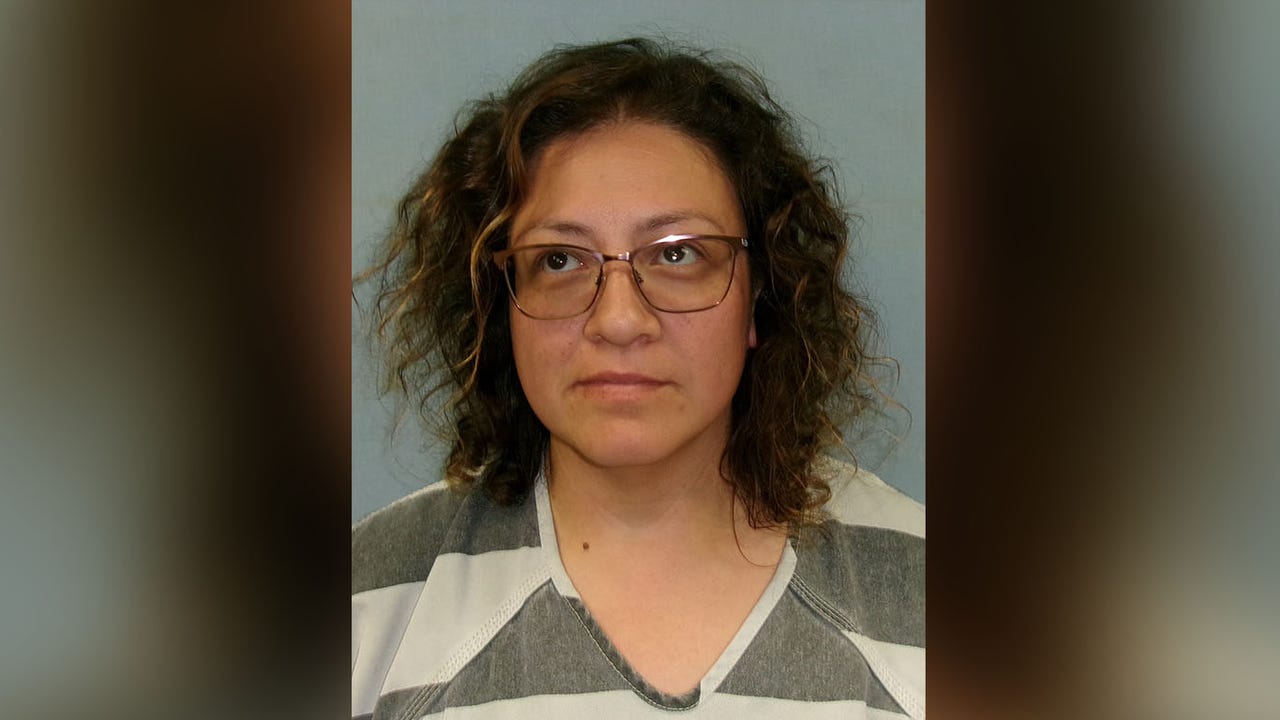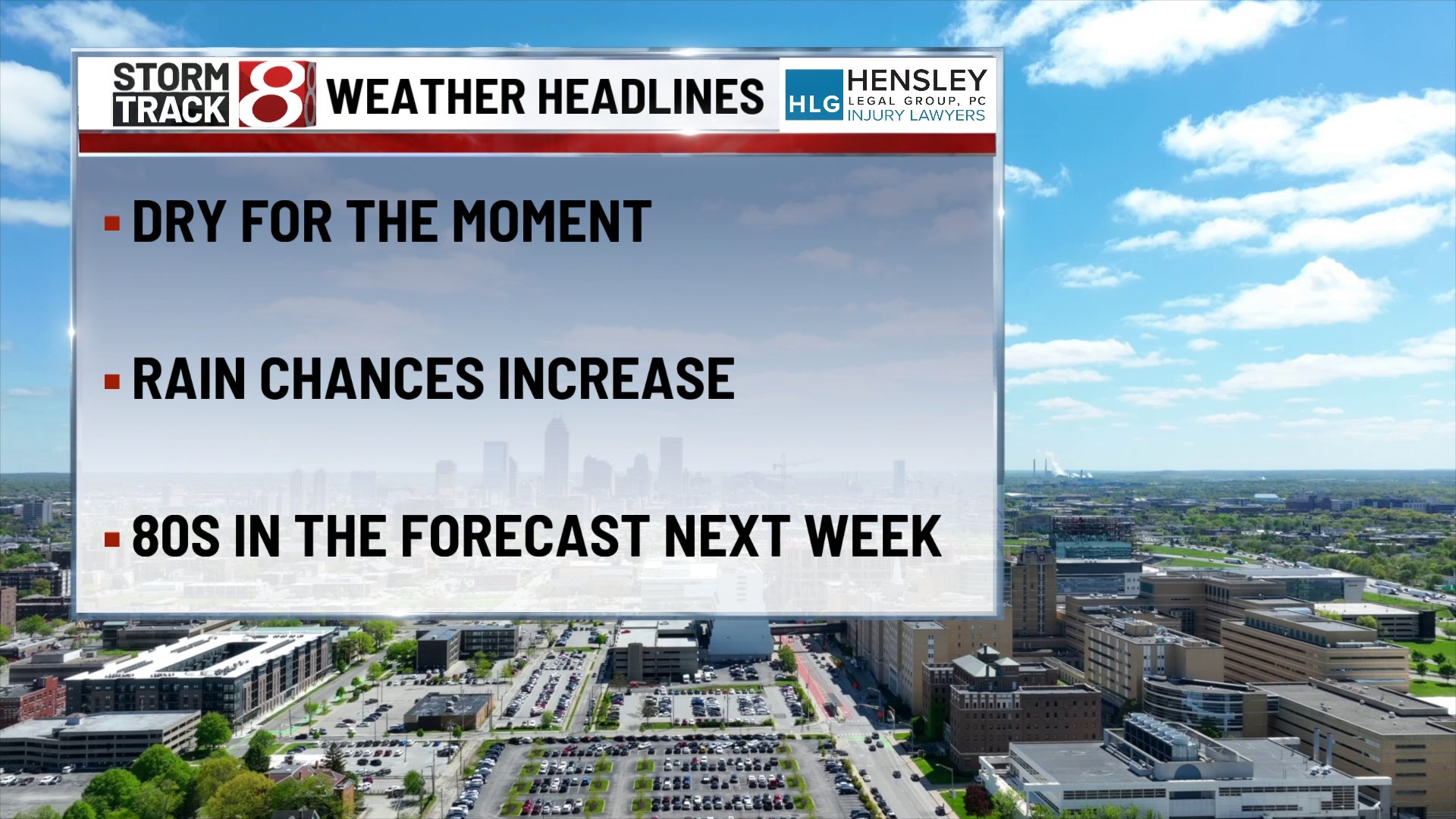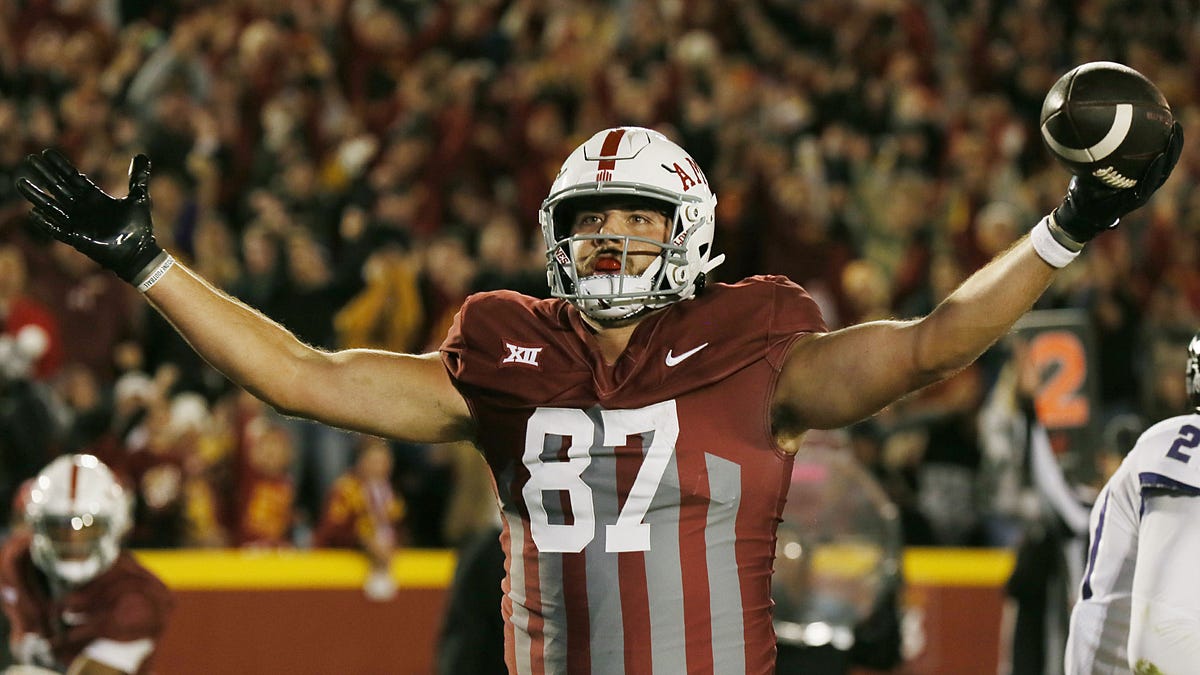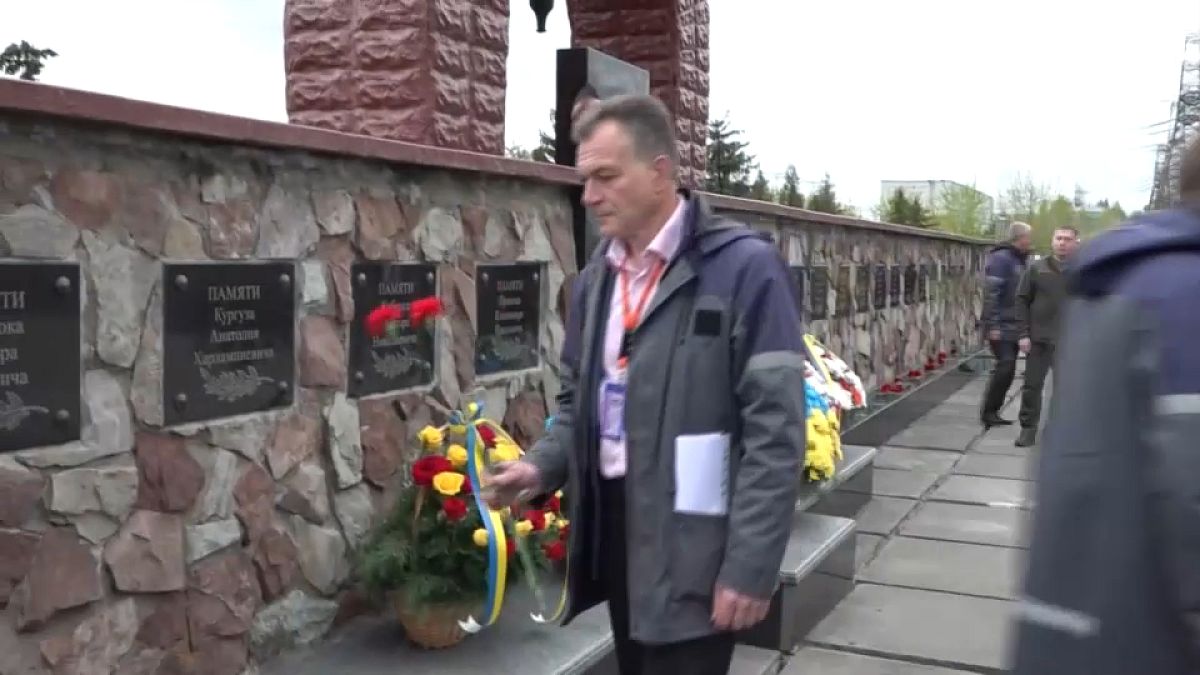Business
California's home insurer of last resort sees enrollment surge, raising concerns over its finances
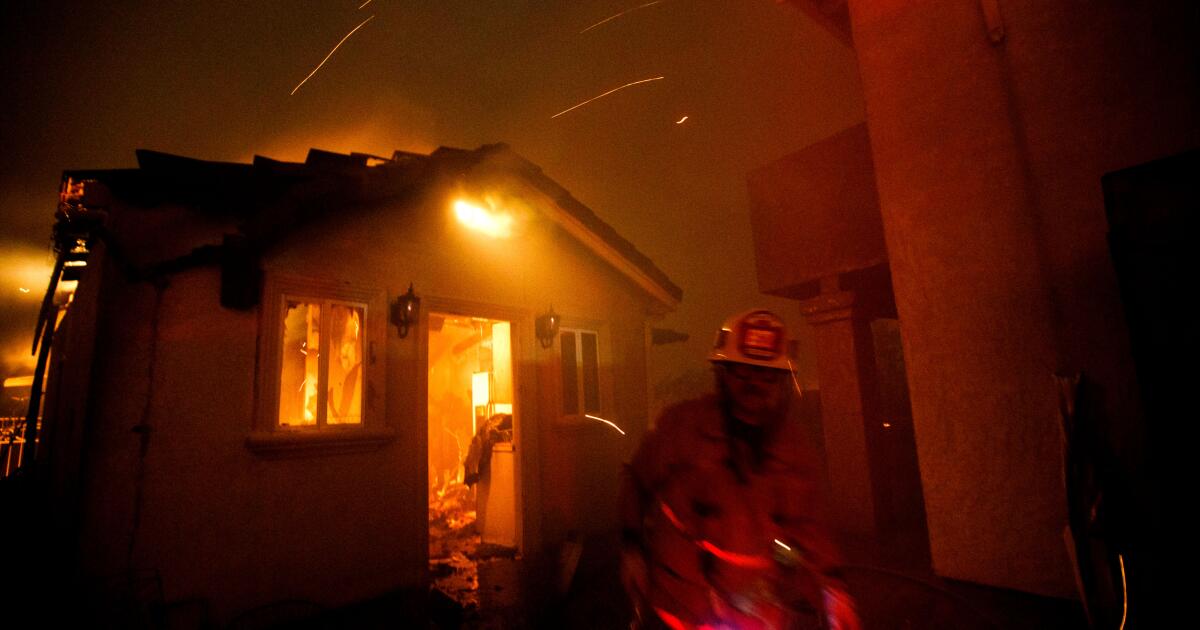
With home insurers scaling back coverage in the state, enrollment is surging in California’s backstop insurance plan — as is the plan’s risk of sustaining losses that it can’t cover.
Victoria Roach, president of the FAIR Plan Assn., told lawmakers this week that property owners even in areas with low wildfire risk were finding it difficult to keep their homes insured as companies increased rates, limit coverage or left areas susceptible to natural disasters amid climate change.
That has prompted thousands of Californians to purchase coverage through the state insurer as a last resort. Funded by the insurers doing business in California, the Fair Access to Insurance Requirement plan provides a limited policy as a fallback for property owners unable to find conventional coverage they can afford.
Roach said the Fair Plan set a new record last month when it added 15,000 new policyholders.
The FAIR plan has about 375,000 policyholders, and the insurer’s total risk exposure was $311 billion as of December 2023; it was $50 billion in 2018.
“We’re one of the largest writers in the state right now in terms of new business coming in,” Roach said. “As those numbers climb, our financial stability comes more into question.”
Roach said homeowners and businesses are typically insured by any of the state’s 118 standard insurers or 132 surplus line insurers, which specialize in high-risk insurance.
“Unfortunately, as you know with the current state of the market, I think this is often reversed because there’s not a lot of options out there for people,” Roach told lawmakers during Wednesday’s Assembly Insurance Committee. “Instead, the FAIR plan is quickly moving to be the first resort for a lot of people.”
She said consumers who would never have sought insurance through the FAIR plan in years past were now among the new policyholders, many of whom were not living in wildfire areas.
The insurer’s expansion is the latest wrinkle in California’s ongoing insurance crisis, and it mirrors a similar trend across the country of major companies dropping customers in areas prone to wildfires, flooding and hurricanes.
Florida’s state insurance of last resort, known as the Citizens Property Insurance Corp., has become the largest property insurer there, adding about 11,000 new policies in the last two weeks, according to local reports.
In Louisiana, state officials have been trying to address an insurance crisis following a series of hurricanes in 2020 and 2021 that caused insurance companies to stop renewing policies or leave the state.
Since 2022, at least eight insurers, led by State Farm and Allstate, have announced plans to stop offering home insurance to new customers or withdraw from the state entirely. Some blamed a spike in the cost of reinsurance — insurance policies that insurance companies buy to cover their big losses — and financial strains caused by inflation that have made materials and labor for home repair and rebuilding costly.
The potential loss of insurers prompted Gov. Gavin Newsom to issue an executive order commanding the insurance commissioner to take action to address issues with the insurance market and expand coverage options for consumers.
Insurance Commissioner Ricardo Lara’s response to the crisis is a set of new rules still being implemented that would allow insurers to raise rates to cover reinsurance costs and projected losses from catastrophic fires, but also require them to provide coverage for more homes in the canyons and hills. The proposals, which aim to move people off the FAIR plan and slow the increase in premiums, have won support from insurance industry trade groups and some consumer groups, but criticism from other consumer advocates.
Under the existing system, insurers need to apply to the Department of Insurance to raise their average rates across the state and prove that the price hike is justified. The process allows consumer advocates to intervene to contest the insurer’s claims.
This system was created when California voters approved Proposition 103 in 1988, but the insurance department went a couple of steps further than the ballot measure. Its rules barred insurance companies from including the cost of reinsurance in their rates and allowed the use only of historical loss data, rather than forward-looking simulations, to support a hike in premiums.
Insurance industry representatives have been trying to lift both of those restrictions for years, but their calls have intensified as insurers have pulled back coverage in California.
On Thursday, Lara proposed a regulation that would allow insurers to use catastrophe modeling that takes into account the projected impacts of climate change and other shifting factors when asking to raise rates.
“We can no longer look solely to the past as a guide to the future,” Lara said in a statement. “My strategy will help modernize our marketplace, restoring options for consumers while safeguarding the independent, transparent review of rate filings by Department of Insurance experts, which is a bedrock principle of California law.”
The proposed regulation comes a week after the Los Angeles County Board of Supervisors approved a motion demanding that Lara investigate the compliance measures that insurance companies require from homeowners to keep their coverage.
“It’s no secret that insurance providers have become more conservative due to increased wildfire threats statewide,” said Supervisor Kathryn Barger, who introduced the motion, in a statement. “As a result, homeowners are increasingly being put in a very tough position: pay higher premiums and comply with varied, costly, and inconsistent mitigation requirements or lose your insurance.”
She added: “I’ve heard from many of my constituents district wide who are facing steep cost increases or being dropped altogether by their insurance carriers and left to fend for themselves. That’s simply unacceptable.”
In response to proposed expansion of catastrophe models, Consumer Watchdog, a consumer advocacy group that often intervenes in proposed rate hikes, said Lara’s proposed regulation limits transparency.
“Black box catastrophe models are notoriously contradictory and unreliable, which is why public review and transparency are key before insurance companies are allowed to use them to raise rates,” the group wrote in a statement. “Commissioner Lara’s proposed rule appears drafted to limit the information available to the public about the impact of models on rates in violation of Proposition 103.”
The group contends that the rule fails to spell out how the Department of Insurance would assess a model’s bias or accuracy and instead creates “a pre-review process that appears primarily focused on determining what information companies must disclose and what they may conceal from public view.”
“California needs a public catastrophe model to ensure climate data is transparent and to prevent insurance price-gouging and bias.”
Staff writer Sam Dean contributed to this report.

Business
California’s wealthiest farm family — and scores of their workers — accuse UFW of bait and trick
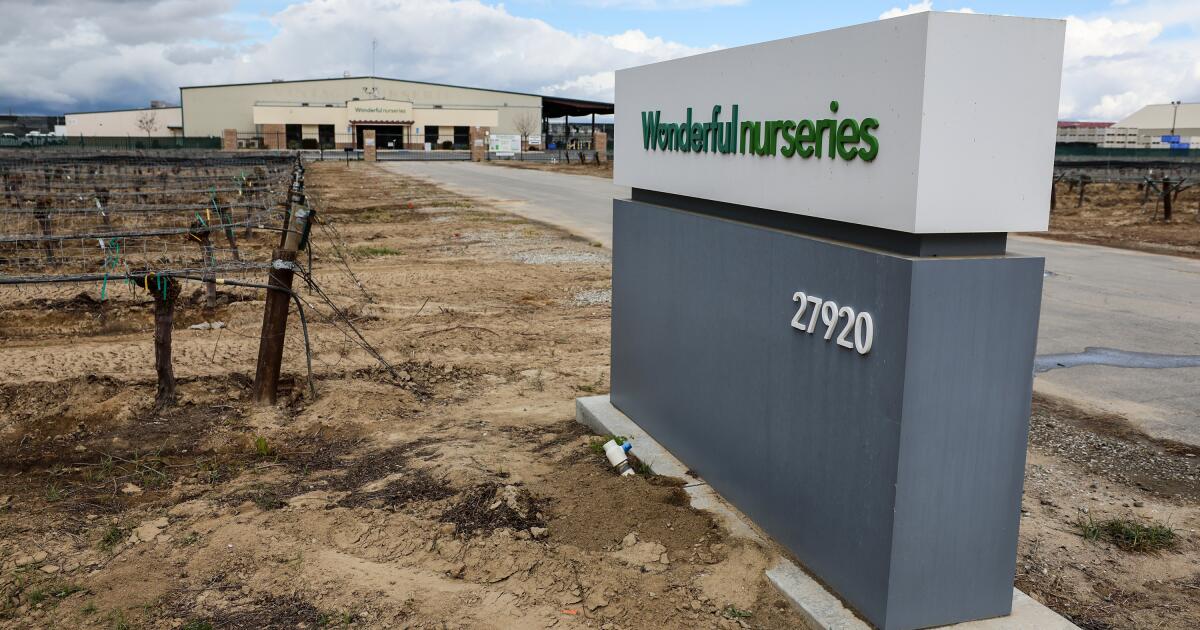
The revelation that United Farm Workers would be representing workers at a Kern County company owned by the state’s wealthiest farming family should have been a triumphant moment for the storied union co-founded by Cesar Chavez and Dolores Huerta.
Following decades of diminishing membership in the vast stretches of California’s farm fields, the UFW had seized on a new way to unionize workers, made possible by recent state legislation. Rather than hold a formal election at a company job site, union leaders had invited employees at Wonderful Nurseries, the nation’s largest grapevine nursery, to off-site meetings where they were instructed in how to apply for $600 in federal relief for farmworkers who labored during the pandemic, as well as encouraged to sign cards authorizing the UFW to represent them at Wonderful.
Labor experts say the outcome of the UFW-Wonderful skirmish could have outsize ramifications on the future of unionizing farmworkers in California.
(Max Whittaker / For the Times)
The UFW subsequently filed a petition with the Agricultural Labor Relations Board, asserting that a majority of the 600-plus farmworkers at Wonderful Nurseries in Wasco had signed the authorization cards and asking that the UFW be certified as their union representative. It appeared to mark the UFW’s third victorious unionization drive in a matter of months.
But within days, Wonderful — part of the farming empire owned by billionaires Stewart and Lynda Resnick — hit back with an explosive allegation: The company accused the UFW of using the $600 in federal relief as bait to trick farmworkers into signing the authorization cards. And it submitted nearly 150 signed declarations from nursery workers saying they had not understood that by signing the cards they were voting to unionize.

Stewart and Lynda Resnick in a 2016 portrait
(Ryan Miller / Getty Images)
Claudia Chavez, a full-time employee of a labor contractor for Wonderful Nurseries, is among several workers who told The Times that they attended meetings where they understood that the UFW would help them claim the $600. She said she was given a card to sign, but didn’t know that signing it was a vote for the union.
“They said clearly — this I do remember — that it was $600 of aid for farmworkers who worked during COVID,” Chavez, 43, said during an interview outside her Wasco home. “But they never said, ‘If you sign, we’re going to come to your work.’”
Union leaders have stood their ground, alleging that the company intimidated workers into making false statements and brought in a labor consultant with a reputation as a union buster to manipulate worker emotions in the weeks that followed.
Antonio De Loera-Brust, UFW’s communications director, called the allegations that workers were tricked into signing union cards “categorically false.” The union has put forward other workers who said they understood what they were signing and believe that UFW representation would improve their pay and working conditions.
Still, what could have been a David-versus-Goliath tale has become something tangled and far more troubling. The UFW and Wonderful are locked in battle, each employing legal muscle and PR prowess, and will present their cases to the ALRB, the state agency charged with overseeing farm labor disputes and union elections.
Labor experts say the outcome could have outsize ramifications for the future of unionizing farmworkers in California. Though still an influential voice in Democratic leadership circles, UFW has seen its on-the-ground presence and sway plummet from its vibrant heyday in the 1960s and ‘70s. At its peak, UFW had about 80,000 members across hundreds of farms. Today, that number has fallen to about 5,000, with another 2,000 in the Teamsters or United Food and Commercial Workers International unions.
If Wonderful is found to have engaged in unfair labor practices, it could be subject to financial penalties. But if the union is found to have misled workers, it faces a blow to its credibility and its nascent resurgence could be stopped in its tracks.
“One way or another it’s going to have an impact on the ability of farmworkers to organize,” said Gaspar Rivera-Salgado, project director at the UCLA Center for Labor Research and Education. “If the union fails and it’s a setback to the organizing, it’s going to be a long while before they can find a foothold to fight for farmworkers in California.”
The UFW-Wonderful skirmish is in some ways an outgrowth of a longer-running clash between labor leaders and California’s powerful agricultural interests over the UFW’s efforts to streamline the unionization process.
For years, UFW leaders had argued that the process for unionizing work sites was stacked against them. Before the new system went into effect, farmworkers voted for union representation by secret ballot at a dedicated polling event, typically held on company grounds. The UFW contends that left workers vulnerable to employer intimidation.
In 2022, Assembly Bill 2183 sought to allow farmworkers to select labor representation through mail-in ballots or a system known as card check, which allows workers to authorize a union by signing cards off-site rather than voting in-person at a designated polling place.
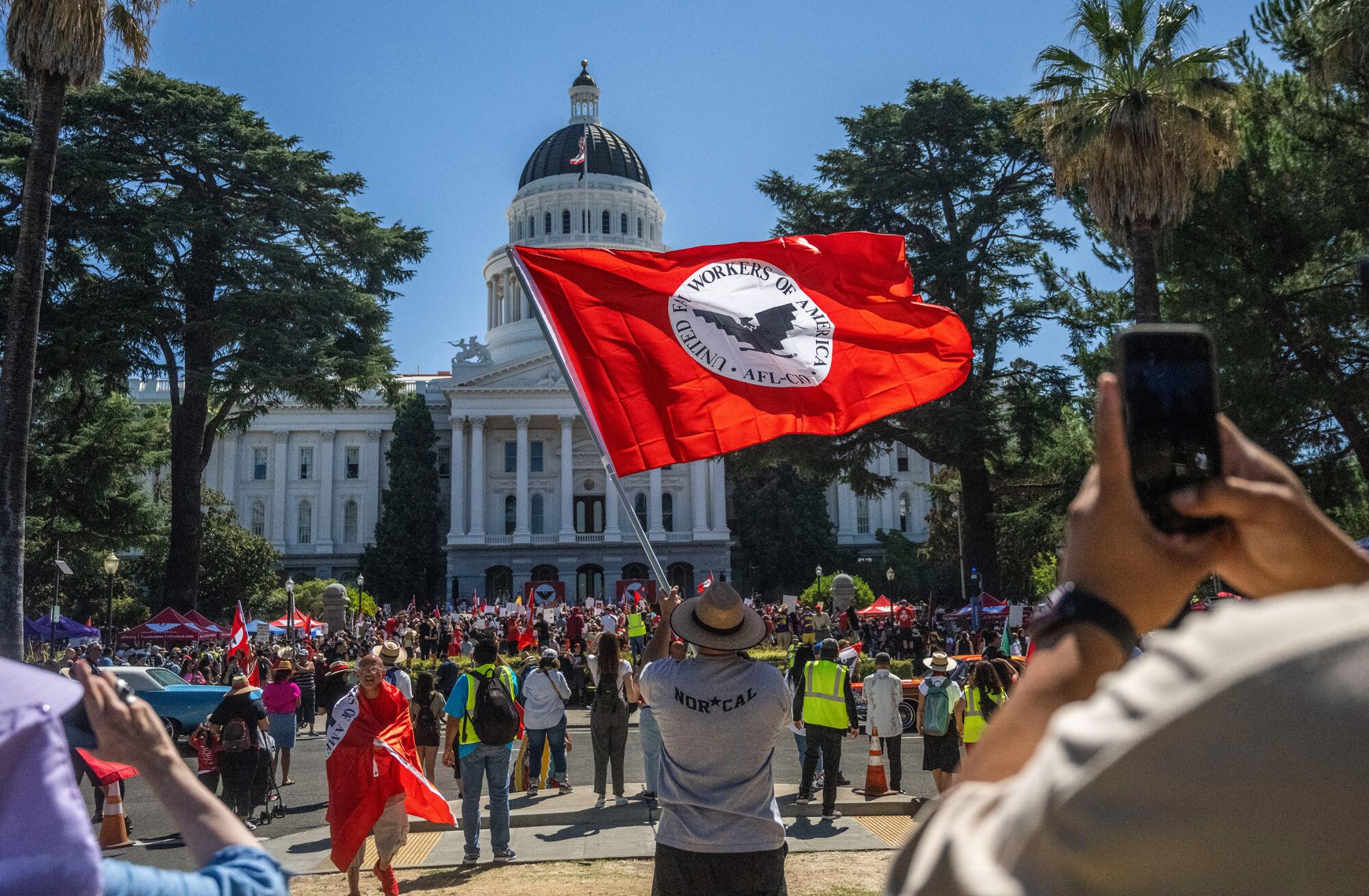
The UFW organized a 335-mile march to ramp up pressure on Gov. Gavin Newsom to sign legislation that would provide more avenues to authorize union representation at agricultural work sites.
(Hector Amezcua / The Sacramento Bee)
Gov. Gavin Newsom had vetoed a similar bill the previous year, citing concerns specific to the integrity of the mail-in balloting. His team signaled he would also veto AB 2183. But President Biden publicly exhorted Newsom to sign the bill, and the UFW organized a 335-mile march from Delano to Sacramento to ramp up pressure.
Newsom signed the bill, under the condition that it be amended to limit certain aspects. In 2023, the law was amended to remove the mail-in ballot option and cap the number of work sites that could be petitioned through card check to 75. It took effect Jan. 1, 2023, and will sunset in 2028.
Under the new system, a union can seek to organize an agricultural work site without notifying an employer. Once union representatives gather enough authorization cards to constitute what they believe is majority support, the union files a petition with the state labor board and the employer. The ALRB must decide whether there is proof a majority of the bargaining unit employees support forming a union.
But as is playing out in the Wonderful case, that process can be appealed.
From the start, the new system has been shadowed by a lack of specifics on the responsibilities of the union and employers in the card check drive. It has taken the ALRB 10 months to publish proposed regulations for the new law, and growers say they feel they’ve been playing a game with no rules.
UFW’s first certification petition under card check landed in Stanislaus County in September when it sought to represent 250 workers at DMB Packing Corp., also known as DiMare, where it won 51% support. DiMare submitted several objections, including an allegation that the union obtained signatures through “fraud” and “coercion.” The ALRB found the allegations lacked evidence.
Guadalupe Luna, 55, said working conditions at the tomato packing company in Newman were miserable — that they had no health benefits, no paid time off and got paid 77 cents for every bucket of tomatoes collected. Before Luna arrived at the farm about a year ago, he said, he worked on a farm in Firebaugh where the UFW represented workers and they received benefits and better pay.
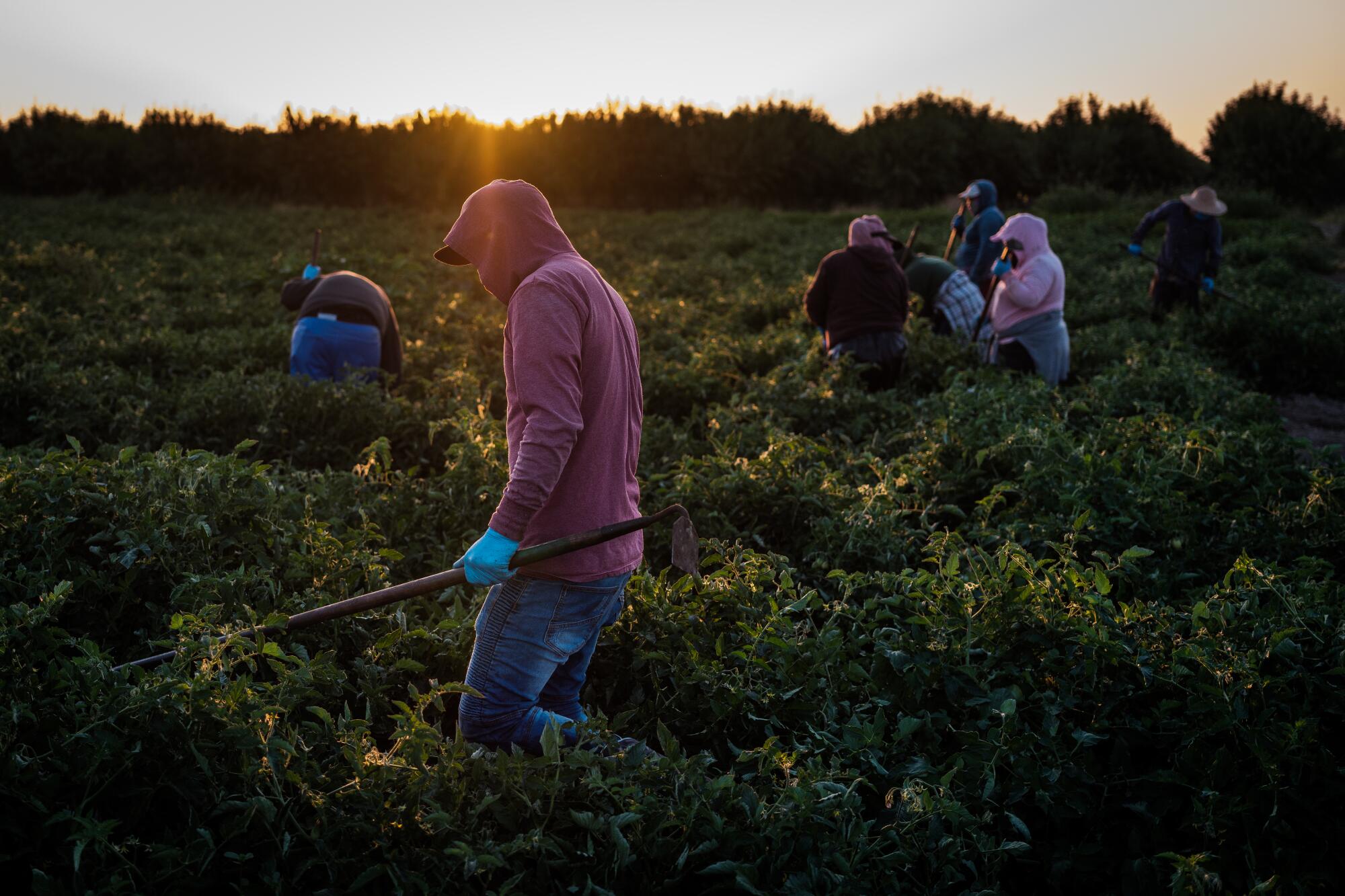
Though still an influential voice in Democratic leadership circles, the UFW has seen its on-the-ground presence plummet from its vibrant heyday in the 1960s and ‘70s.
(Max Whittaker / For the Times)
Luna, who is on the bargaining committee for the union, said the UFW meetings he attended with co-workers were focused on the benefits of unionizing and did not include conversations about the $600 federal relief payments. “The coworkers I spoke with, we talked and there wasn’t that [confusion].” he said. “We just talked to them and explained the process.”
DMB Packing President Jeff Dolan said the company is appealing the labor board’s decision. Nonetheless, he said, negotiations with the UFW and workers have been “cordial and positive.”
In Fallbrook, 50 miles north of San Diego, the UFW submitted a petition in January to represent more than 70 employees at Olive Hill Greenhouses. According to the ALRB, no objections were filed, and both sides are at the table to negotiate their first contract.
Santiago Hernandez was among those eager to unionize workers at the Fallbrook nursery. He said he told colleagues to talk to a UFW organizer and explain what they wanted out of their jobs and decide if they wanted to support a union.
The first meeting, he said, was about starting a union and they received the authorization cards to consider. He said the last meeting he attended, where people could drop off the cards, also allowed people to sign up for the $600 in relief. He did not hear from colleagues about being tricked, he said, and felt it had been clearly communicated that the two were not linked.
“The union is here to help farmworkers, not to screw with farmworkers,” Hernandez said.
One of the largest employers in the Central Valley, the Wonderful Co. prides itself on its treatment of farmworkers, including paying above minimum wage and extending company benefits — like free use of its health centers and gyms — to full-time employees. Wonderful has also invested millions of dollars in farmworker communities in Kern County, building parks and schools and improving infrastructure.
The Resnicks, owners of FIJI Water, Wonderful Pistachios and POM Wonderful, are major political donors who have contributed more than $220,000 to Newsom’s campaigns alone.
The workers at Wonderful Nurseries’ sprawling complex in Wasco tend to wine and table grapevines and nut tree rootstocks. In both the company and union narratives about the card check episode, the workers have been portrayed as pawns in a much larger game. The divergent narratives offer little room for a middle ground, for example whether there could have been some confusion in the meetings because of a general lack of understanding of the UFW’s role.
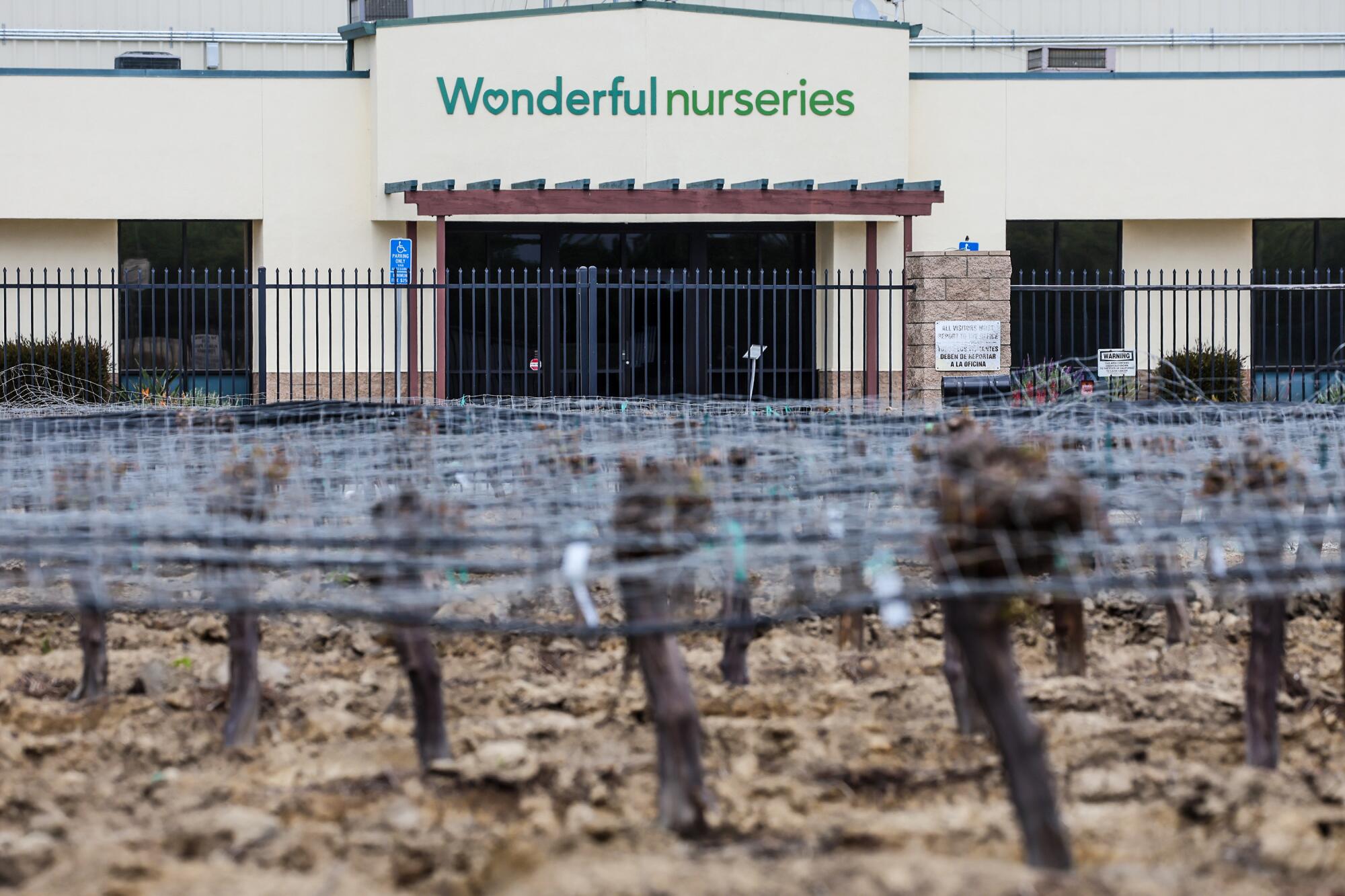
One of the largest employers in the Central Valley, the Wonderful Co. has invested millions of dollars in farmworker communities in Kern County.
(Robert Gauthier / Los Angeles Times)
There does seem to be general agreement that the organizing meetings for Wonderful employees incorporated discussion of both the federal relief payments and the unionization drive. The U.S. Department of Agriculture has authorized several organizations to distribute the one-time grants, including the UFW Foundation, which is separate from the labor union.
Rosa Maria Silva de Rodriguez, 40, who has worked at Wonderful Nurseries for five years, said she hosted several of the meetings at her home last year. She said she wants a union because she feels workers are being mistreated. The water provided in 5-gallon coolers was inconsistently refilled and cleaned, she said. She said she’s had uncomfortable situations in which male coworkers made suggestive comments about women and she knew of no avenue for reporting it.
Silva de Rodriguez said it was clear at the meetings that the federal relief money was not tied to signing a union card. The UFW representative “always talked about the rights of workers, what it meant to form a union, to bring in a union, what the union would do,” Silva de Rodriguez said.
Yet other workers interviewed by The Times spoke in equally heartfelt terms about feeling duped.
Maria Pedro, 27, makes $16.30 an hour as a seasonal worker for a labor contractor at Wonderful Nurseries. She likes that the work in the greenhouses is indoors — and therefore dependable, even when it rains.
“Look, I just got home, and I’m clean,” Pedro said on a recent afternoon, as she sat at a table in her work clothes, khaki-colored pants and a black, long-sleeved shirt.

The workers at Wonderful Nurseries’ sprawling complex in Wasco tend to wine and table grapevines and nut tree rootstocks.
(Robert Gauthier / Los Angeles Times)
She described attending a meeting last year at a colleague’s home in Wasco. She said a UFW representative was there to help Pedro and others apply for the $600 federal grant. As a single mother of three, the money would help her pay rent and buy diapers.
Pedro, who emigrated from Guatemala five years ago, said she had never heard of the union. But during the meeting, the rep explained that the organization helps farmworkers assert their rights. Pedro signed several documents. Among them was a white card emblazoned with the union’s eagle logo that reads, in English and Spanish, “I authorize the Union of Farm Workers of America to be my union representative to collectively negotiate an employment contract with my employer to improve my wages, working conditions and benefits.”
The union rep never asked if the workers wanted to join the union and didn’t explain the significance of the cards, Pedro said.
On Feb. 23, the UFW filed a petition with the ALRB to represent Wonderful Nurseries employees. Several workers, including people for and against unionizing, described attending meetings days later, led by an outside consultant, Raul Calvo, who has built a business advising farm companies on how to avoid unionization. The workers said Calvo told them about the union’s entrance into Wonderful Nurseries and that once the contract was ratified, 3% of their paycheck would go toward union dues.
Pedro said it was only then that she realized that, by signing the card, she had voted for the UFW to represent her. “Thanks to him, we understood what was happening, because the union never really explained what they did,” she said.
If her name was on the petition, Pedro said, she wanted it removed and asked Wonderful for help. She was among the workers who signed a declaration.
Silva de Rodriguez, on the other hand, contends Calvo was the first to suggest employees were tricked. She said workers began admitting to supervisors that they had signed the union card and faced pressure to renounce their support. She said she has seen workers who once supported the unionization effort now protest against it.
“It bothers me, but at the same time, it gives me a bit more strength, because I am fighting for something fair, something fair for everyone,” she said.
The union filed a charge against Wonderful Nurseries, alleging the company required workers to attend a “captive audience” meeting to urge employees to reject UFW representation. Wonderful Nurseries maintains it “provided interested employees with factual information about the process and their rights.”
Calvo confirmed to The Times he is working for the company but declined to answer questions about his role.
The ALRB acknowledged receiving worker declarations on March 1 and called the allegations “serious in nature.” Three days later, the regional director of the labor board moved forward to certify the union’s petition, determining the UFW had submitted 327 valid authorization cards from a bargaining unit of 640, establishing majority support.
The dispute crystallized last week when about 100 Wonderful Nurseries workers left work and traveled 60 miles north to the labor board’s Visalia office. They sported the orange safety vests they’re required to wear at work and carried signs reading, “We don’t want a union! Listen to our voices. Don’t ignore us.”
While the company and two participants who spoke with The Times were adamant the demonstration was worker-led, the UFW has filed a charge with the board alleging that Wonderful Nurseries coerced workers into attending.

About 100 employees of Wonderful Nurseries who say the UFW used deceptive tactics in its unionization drive stage a protest at the Agricultural Labor Relations Board in Visalia.
(Courtesy of Claudia Chavez)
Last week, in yet another escalation, a Central Valley law firm that frequently represents the UFW filed charges with the state Civil Rights Department on behalf of seven workers, including Silva de Rodriguez, alleging that Wonderful Nurseries doesn’t provide sexual harassment training, resulting in a “hostile work environment.”
Wonderful fired back, dismissing the charges as “bogus claims.” In a statement, company President Rob Yraceburu said every manager, including those employed through third parties, is in compliance with all mandatory training, and that the company provided the UFW with its employee handbook, which includes its harassment policy, a week before the charges were filed.
“It’s getting harder to keep up with the fire hose of lies the UFW is pushing in their effort to divert attention from their fraudulent conduct in a vote decided by just seven votes, but where more than 150 farmworkers say they were misled,” Yraceburu said.
Wonderful has appealed the UFW certification. The state labor board is expected to meet this month to consider the company’s objections.
This article is part of The Times’ equity reporting initiative, funded by the James Irvine Foundation, exploring the challenges facing low-income workers and the efforts being made to address California’s economic divide.
Business
Bitten by a billionaire's dog? Or a case of extortion? A legal saga from an L.A. dog park

A dog-bites-woman story usually isn’t much of a story at all. But an incident in one of L.A.’s wealthiest enclaves has become something else entirely.
What began in a Brentwood park on a summer day in 2022, when a dog owned by billionaire surgical-device inventor Gary Michelson allegedly bit another pet owner, has turned into dueling lawsuits and an allegation of blackmail.
Michelson claims it’s a simple case of extortion. He says interior designer Sandra Evling tried to force him to pay her $85,000 by threatening to publicly humiliate him and report his dog to authorities, which she claimed would lead to the pet being put down. He filed suit first, seeking damages in excess of $250,000.
From Evling’s perspective, he should have known better. She alleged Michelson, a philanthropist prominent in animal welfare circles, let his dog run free despite knowing it had bitten other animals and one other person — traumatizing her and causing severe injuries, according to a personal injury lawsuit she filed in response seeking unspecified damages.
In a town where the rich have legitimate fears of extortion, is this a case of a person seeking a payday? Or a billionaire using his wealth and legal savvy to protect himself from responsibility for an aggressive animal?
Dr. Gary Michelson at a 2019 gala for his Michelson Found Animals Foundation in Beverly Hills.
(Albert L. Ortega/Getty Images)
Michelson, 75, seems an unlikely antagonist in a dog-bite case. After reaching a $1.35-billion patent dispute settlement with medical device maker Medtronic two decades ago, he has made a name for himself as a philanthropist in animal welfare and other fields.
After Hurricane Katrina in 2005 orphaned more than 100,000 pets, he established the nation’s first free microchip pet registry. He has a standing prize offer of $25 million for the development of a single-dose medication that can permanently and safely sterilize both cats and dogs.
Michelson’s devotion to animal welfare extended to his own pet Blue, a beige-and-white dog with droopy eyes he celebrated on Instagram with the tongue-in-cheek handle @scarypitbully. The page, since taken down, documented the maturation of the American bully XL, the largest of a muscular breed derived from the American pit bull terrier that the United Kennel Club describes as more gentle and playful, making it an excellent family dog.
Michelson and Evling, 37, an immigrant from Sweden, were regulars at Veterans’ Barrington Park. They lived nearby: Evling in an apartment and Michelson in a $24-million mansion.
The incident took place Aug. 9, 2022, just outside a fenced-in dog park on ball fields where owners let their dogs run free.

Dogs tend to play off-leash on a sports field adjacent to the dog park at Veterans’ Barrington Park.
(Robert Gauthier/Los Angeles Times)
Evling, in her lawsuit, said that she was walking with her dog Neo, a tamaskan, when Blue charged her pet, and that she was bitten trying to protect it. She sought treatment that evening at an urgent care clinic complaining of pain in her left hand from a crush injury and an abrasion to her right elbow, according to medical records reviewed by The Times.
An X-ray found no fractures or vascular injuries in her hand, which was put in a finger splint. She was given a tetanus shot and prescribed antibiotics, the records show.
In messages sent to The Times, Michelson said the records are not evidence of dog bites, claiming instead she might have twisted her finger on her dog’s collar and scraped her elbow while falling. He said that afterward he checked on Evling “for days” and offered to pay her medical bills. He said that the calls were cordial and that she “seemed ok.”
Michelson said he also set up a session at his house with celebrity dog trainer Cesar Millan, a longtime friend, to work with Neo and Blue together so that “Sandra could feel comfortable at the dog park with Blue around.”

Gary Michelson’s dog Blue.
(Courtesy of Gary Michelson)
After the session, Michelson said, he and Evling would see each other at Gold’s Gym Venice, where they both brought their service-dog pets. He said that “things were always quite friendly” and that Evling never complained of being bitten until she learned of his wealth.
Attorney Benjamin Taylor, who represents Evling in the extortion lawsuit, said Evling knew Michelson’s background “well before this incident.”
On April 20, 2023, eight months after the alleged attack, Evling texted Michelson asking to meet the next day at the gym, according to a copy of the pair’s text string provided by former Los Angeles County Dist. Atty. Steve Cooley, a friend of Michelson’s who is listed as one of his attorneys in the extortion lawsuit.
Their conversation continued via texts. Evling complained she was suffering from “severe PTSD” and a lifelong scar from the attack, and chastised Michelson about another alleged incident at the park involving Blue.
“When I was told that you had taken Blue off leash at the park this week and that he had attacked another dog all my trauma came back (like it happened all over again) and a severe anger that you’re not taking this problem seriously. Is it going to take someone getting killed before you realize how serious this is?” she texted. (Michelson denied Blue ever attacked another dog or person in answers to a list of questions sent to Cooley in February.)
Evling, who had stated she didn’t want to involve attorneys, laid out two options.
If Michelson chose Option A, she would have him and his dog expelled from the gym, file a report with police and animal control that would result in the dog being put down, and file a class-action lawsuit with other parkgoers that “will cost you a loooot of money.”
If Michelson chose Option B, Evling texted, he could keep Blue as long as he paid her $85,000, kept his dog on a leash and didn’t bring it to the park. She promised not to file a complaint with the gym so long as Michelson kept Blue away from her while she was training. She added she would sign a nondisclosure agreement that would be voided only if Blue attacked her or her dog again, not if Blue was aggressive with others.
“It is time for you take responsibility and suffer the consequences of your actions,” she texted.
Several days later, Michelson asked Evling how she arrived at the compensation figure and how he and his wife, recording artist Alya Michelson, could trust that she wouldn’t carry out her threats anyway.
Evling said she had consulted with several law firms and claimed the $85,000 would be less than a court judgment. She assured him she wouldn’t talk to anyone or file legal action. “I AM a person of my word and just want to move on as much as you do and leave this in the past,” she texted on April 27.
The negotiations then turned sour. Michelson told Evling he had just learned from several dog park friends that she was recruiting plaintiffs for a lawsuit, accusing her of “already breaking your promise.” However, he said he was immediately sending a “good faith” payment of $10,000 if she would not take the steps she had outlined. “Hopefully, this small measure of restraint will be acceptable to you,” he texted.
Evling disputed that she was preparing a lawsuit, contending she had only learned of the new alleged attack through a dog park chat group.
After being assured the $10,000 was a partial payment, Evling said she would not take further action as long as she received a contract by May 15 for the remainder of the $85,000. Michelson filed his extortion lawsuit days later on May 3.
Taylor said Evling had sought payment to resolve the matter informally without attorneys in the hopes of avoiding a “spectacle.” “Now that Dr. Michelson decided to sue her first, she looks forward to her day in court,” he said.
Attorney Ryan Baker, a founding partner of L.A. law firm Waymaker, reviewed the exchange to offer an opinion on whether it amounted to civil extortion, which under California law includes receiving a benefit such as money through the threatened exposure of any “disgrace or crime” even if falsely alleged.
Baker said that Evling had the right to pursue a private settlement under the threat of her own lawsuit, but if she threatened to report Michelson unless he met her demands she crossed a “bright line.” “She can’t become her own private judge, jury and executioner,” he said.
Michelson was “extremely shrewd,” he said, to seek the demands in writing and send the $10,000, since receiving it would be a key element of civil extortion.
Baker said a “critical question” a jury would have to decide was whether Evling had extorted the money or had simply received and kept it.
After Evling was sued, she filed a personal injury lawsuit that claimed Blue had bitten four dogs and one person in 2022 before the attack on her, and one poodle afterward.
Her lawsuit provided few details about the other alleged attacks. Blue, though, was a topic of a dog park group chat on April 17, 2023 — the day of the alleged poodle attack. Multiple members of the chat alleged that Michelson brought his dog to the park and that his dog had repeated altercations with other animals.
Michelson denied Blue has a history of aggression, contending “chat rooms are not acceptable or reliable sources of factual information,” in response to the questions sent Cooley. He said that Evling’s characterization of his pet, which is referred to as a “vicious animal” in her lawsuit, “reeks of outdated stereotypes.”
Michelson pointed to a lack of complaints with Los Angeles Animal Services as evidence, which the department confirmed in February in response to a California Public Records Act request.
Judie Mancuso, the founder of Social Compassion in Legislation, a public policy group that advocates for animals in Sacramento, said Blue was “super well behaved” at a fundraiser Michelson and his wife hosted for the nonprofit in July at the couple’s Brentwood home.
“The dog didn’t even bark at anyone,” Mancuso said.
At the time of the dog park incident, neither of their dogs were neutered. Michelson said in a text this was to allow Blue to compete as a purebred show dog. He said he opted to have Blue neutered last month because of the difficulty of participating in competition with a dog whose breed is not recognized by the American Kennel Club. “As I am a champion for S&N [spay and neuter], I gave up and had him neutered,” he texted.
Evling’s dog was 8 months old at the time. He has since been neutered, according to Taylor.
In support of her allegations that Blue was aggressive, Evling collected the names and numbers of some two dozen people she alleged had witnessed attacks, including 12 chat group members, whose identities were disclosed in court filings. The Times attempted to contact all of them; most did not respond or would not comment publicly.
Syed Ahmed, a Brentwood data analyst, was an exception. He said that his dog Turbo, a male 70-pound Doberman pinscher, and Blue got into a fight in March 2022 and that Michelson’s dog “ended up grabbing my dog by the throat.” Evling’s lawsuit alleged a dog of that name was bitten that month.
Turbo was treated for puncture wounds, according to a veterinary bill provided to The Times, along with photos of the bite wound.
Ahmed said he didn’t ask Michelson to reimburse him for his $908.10 bill. Michelson “was very apologetic, and that’s why I didn’t pursue anything. I was like, OK, you know, s— happens,” he said.
After Michelson learned from The Times last month that the dog had been injured, he reimbursed Ahmed for his veterinary bill.
Michelson said that he believed Turbo just wanted to play, but that Blue bit the dog because he had been attacked several times by other male dogs. “Blue misread the dog’s intent and reacted to protect himself. I was very upset that it happened,” he emailed. “I will testify under oath that I have never seen Blue attack anyone, ever.”
Michelson’s and Evling’s lawsuits are wending their way through Superior Court. Trial dates for each have been set for next year.
In early December, Evling saw Westside plastic and reconstructive surgeon Michael Zarrabi to examine the scar allegedly left by the dog bite on her right elbow. Zarrabi called the injury “disfiguring” and recommended surgery, multiple laser treatments and topical ointments that he anticipated would improve the appearance 80%, according to medical records reviewed by The Times. The estimated cost: $41,900.
Michelson, in a text, called the estimate “beyond absurd.” He said in an email that he consulted a “well-regarded” Beverly Hills plastic surgeon who, after seeing pictures of the abrasion, said the scar tissue could be removed for $5,000 — half the $10,000 he had already sent her.
As the two parties await trial, Evling has started a business selling Swedish cookies, while Michelson has remained active in civic and philanthropic circles. He rubbed elbows with Gov. Gavin Newsom at an event announcing UCLA’s acquisition of the former Westside Pavilion mall, which the university is converting into a research park. It will house the California Institute for Immunology and Immunotherapy, which Michelson chairs and has pledged $120 million toward.
One place he apparently has not been in a long while is the Barrington dog park.
After the alleged poodle attack, Michelson texted Evling that he was never going to the dog park again and “it is my intention to stay as far away from you as possible.”
Taylor said she had stopped going there too.
Business
Column: As taxpayers tire of handouts to billionaires, Major League Baseball demands public funding for a Vegas stadium

The longest-running melodrama in sports is less about events on the field of play than on machinations in the ownership suite of baseball’s Oakland A’s, who are close to finalizing a move to Las Vegas three or four years from now.
At least, that’s the hope of Major League Baseball and the team’s billionaire owner, John Fisher. That the deal will ultimately close as expected is the way to bet, to speak the language of Las Vegas.
But increasingly there are grounds to take the under. As my colleague Bill Shaikin reports, two challenges to the public funding for the team’s proposed new Vegas ballpark have emerged from a Nevada teachers union.
During the last Legislative Session, with important education issues outstanding,…Nevada politicians singularly focused on financing a ‘world-class’ stadium for a California billionaire.
— Nevada State Teachers Assn.
Strong Public Schools Nevada, a political action committee of the Nevada State Education Assn., has filed a lawsuit questioning the public funding as unconstitutional. A separate committee of the union is pressing to qualify for November’s state ballot a voter referendum on the funding.
At issue is a measure signed last year by Nevada’s Republican governor, Joe Lombardo, authorizing $380 million in public funding for a ballpark estimated to cost $1.5 billion. The rest supposedly would come from Fisher and any other private investors he persuades to come on board.
The absurdity of making a grant of public money to a billionaire and his rich cronies for a sports venue while other public needs are more pressing isn’t lost on the teachers, and it shouldn’t be lost on anyone else.
“Nevada ranks 48th in per pupil funding with the largest class sizes and highest educator vacancies in the nation,” the teachers union stated when it filed its lawsuit in February. Yet “during the last Legislative Session, with important education issues outstanding … Nevada politicians singularly focused on financing a ‘world-class’ stadium for a California billionaire.”
They’re right. Fisher, whose net worth is estimated by Forbes to be $3 billion, is the quintessential member of the Lucky Sperm Club, not to be indelicate. He’s an heir of Donald and Doris Fisher, founders of Gap Inc. Forbes ranks his “self-made score” at 2 on a scale of 10, meaning that almost all his wealth was inherited.
As I wrote last year, since becoming the sole owner of the A’s in 2016, Fisher has systematically dismantled the team and allowed its home stadium, the Oakland Coliseum, to crumble away.
The nearly 60-year-old multipurpose park was always a terrible place to watch a baseball game, with seats ridiculously distant from the action, but in recent years the experience has only gotten worse. During one game, the stadium flooded with sewage. On another occasion, the lights went out. Feral animals roamed the increasingly vacant corridors. Then, for the 2022 season, Fisher doubled season ticket prices.
Meanwhile, he and MLB commissioner Rob Manfred shed crocodile tears over the lack of fan support in Oakland. But what kind of product have Fisher and MLB been asking fans to pay for? In a nutshell: The A’s stink. Last year they turned in the worst record in baseball by losing 112 of their 162 games. They scored 339 fewer runs than they gave up to opponents.
This record was the product not of chance, but design. The team payroll last season of $43 million ranked dead last in the league, 12% of the league-leading New York Mets (who, to be fair, hardly made the most of their $334-million payroll, losing nearly 54% of their games). The best-paid player on the A’s, shortstop Aledmys Diaz, batted .229 last year and has started this season on the injured list.
Fisher embarked on an ostensibly serious search for an alternative venue in the Bay Area. Oakland municipal officials trying to work with him on a plan to keep the team accused him of sabotaging those efforts, in part by insisting on massive subsidies for expansive joint stadium/commercial/residential developments.
Oakland A’s owner John Fisher
(Michael Zagaris / Getty Images)
The A’s have announced that after completing their sojourn in Oakland at the end of the season, they’ll play in the ballpark of the minor league Sacramento River Cats for the next three years, maybe four, while their new stadium rises on the Vegas Strip site of the Tropicana Hotel, which is due to be demolished this year.
The Sacramento ballpark has about 14,000 seats, but it may still seem almost vacant when the A’s play there, as the average attendance at the team’s 13 home games in Oakland so far this year is 6,243, worst in the league by an unhealthy margin. The last year that average home attendance at A’s games exceeded 14,000 was 2019. At a game last May between the A’s and the Arizona Diamondbacks, only 2,064 seats were occupied, the lowest attendance for an A’s game in 44 years.
So what would Las Vegas gain from importing the A’s? Probably almost nothing. In very rare cases, a new sports venue can augment economic activity in a town or city, usually one with little else in sports or entertainment on offer.
Las Vegas is not exactly the kind of community in desperate need of another tourist draw. An A’s ballpark — or for that matter, the NFL Raiders’ Allegiant Stadium, where this year’s Super Bowl was held — can’t do much for a city where hotel occupancy is generally close to the highest in the nation.
As Bloomberg reported earlier this year apropos of Allegiant, “had the $1.9 billion stadium not been built at all, Las Vegas businesses wouldn’t have noticed the difference.” And any time that tourists spend at a ballgame is time they’re not spending inside the city’s true cash cows, its casinos.
Even when a new venue brings in new dollars, the gains for the home community typically comes at the expense of its larger region. Think of it as the Inglewood effect: This outpost of 110,000 residents may be seeing more business from SoFi Stadium, where the NFL Rams and Chargers play, but the chances that it has had a measurable impact on Los Angeles County (population 9.7 million) are minuscule to the point of being nonexistent.
Some Inglewood business owners and residents, as it happens, are complaining that the project has brought them increased traffic and noise; higher residential and commercial rents have forced some residents and businesses out of the city.
That brings us back to the challenges to the Vegas stadium financing brought by the Nevada teachers. The clock is ticking on both the union’s lawsuit and its proposed ballot measures. Since February, almost nothing has happened in the Carson City courthouse where the lawsuit was filed.
That makes the A’s nervous, for the legislative authorization for public financing expires 18 months after MLB’s approval of the team’s relocation, which was delivered on Nov. 16 with a unanimous vote of the MLB team owners — giving the team a deadline of mid-May 2025 to complete all its necessary agreements with local authorities. That places the deadline a bit more than a year from now, assuming the court allows the legislation to stand.
If the legislation is overturned, the team and its government promoters would be back at square one. That’s why the team petitioned the court a few days ago to allow it to intervene in the lawsuit, which would allow them to speak up for their own interests in court. “The Athletics … will be affected if SB 1 is found unconstitutional,” A’s President Dave Kaval declared in a court filing. “Each year of delay will cost the Athletics millions of dollars.”
The union’s effort to overturn the public financing at the ballot box is also moving slowly through the Nevada courts. Its petition to place a referendum on the November ballot was invalidated in November by a state judge. The union appealed to the Nevada Supreme Court, which heard oral arguments on the case April 9 but hasn’t issued a decision.
The union has until June 26, or just over two months from now, to collect more than 102,000 valid signatures of registered voters to place the referendum on the November ballot. But it can’t start the process until the court resolves the validity of its petition.
That’s important, because there are indications that Nevada voters are less than eager to spend public money on the A’s stadium. A poll released April 4 by the nonpartisan polling center of Boston-based Emerson College found that 52% of voters are opposed to the public funding, against only 32% in favor and 17% unsure.
The public financing of stadiums for team owners who could pay for construction out of their own pockets peaked in the 1990s, when voters finally got fed up with giveaways that left their cities and states holding the bag for venues that consistently ran in the red.
The trend faded, but never entirely disappeared. Recently, it has experienced a revival. Last year, the New York legislature and Erie County approved subsidies totaling at least $850 million for a new stadium for the NFL‘s Buffalo Bills. The team’s owner, oil and gas tycoon Terry Pegula, is even richer than Fisher, with a net worth of $6.8 billion, according to Forbes; he’s also almost entirely a self-made man.
Pegula brought the politicians to heel by threatening to move the team to Austin. The result was the largest taxpayer handout in U.S. sports history, narrowly edging out the $750-million subsidy Nevada posted to bring the NFL Oakland Raiders to Las Vegas in 2022.
The game of rent-seeking that Fisher has played with Oakland and Las Vegas is every bit as humiliating for taxpayers as the Bills and Raiders deals. It will make the A’s the most-traveled pro sports team in American history, having originated as the Philadelphia Athletics under the legendary Connie Mack in 1901 before moving to Kansas City in 1955 and Oakland in 1968, with Sacramento and Las Vegas now in its future.
So a sports franchise with 15 American League pennants and nine World Series titles to its name and more than 100 years of loyal fandom in three cities will continue its existence as a token of Major League Baseball’s unsavory dalliance with the gambling industry.
The supine political leaders of Nevada should be ashamed at sticking their constituents with a billionaire’s invoice. The lords of the MLB should be ashamed of so shabbily treating the fans who supported the Oakland A’s through four World Series titles and stuck with them until Fisher made the spectacle on the field simply unwatchable.
Here’s an easy prediction: This won’t be the last time that pro sports owners show their willingness to treat their fans like crap, as long as someone is off in the distance waving millions of dollars around.
-

 Movie Reviews1 week ago
Movie Reviews1 week agoMovie Review: The American Society of Magical Negroes
-

 World1 week ago
World1 week agoIf not Ursula, then who? Seven in the wings for Commission top job
-

 Kentucky1 week ago
Kentucky1 week agoKentucky first lady visits Fort Knox schools in honor of Month of the Military Child
-
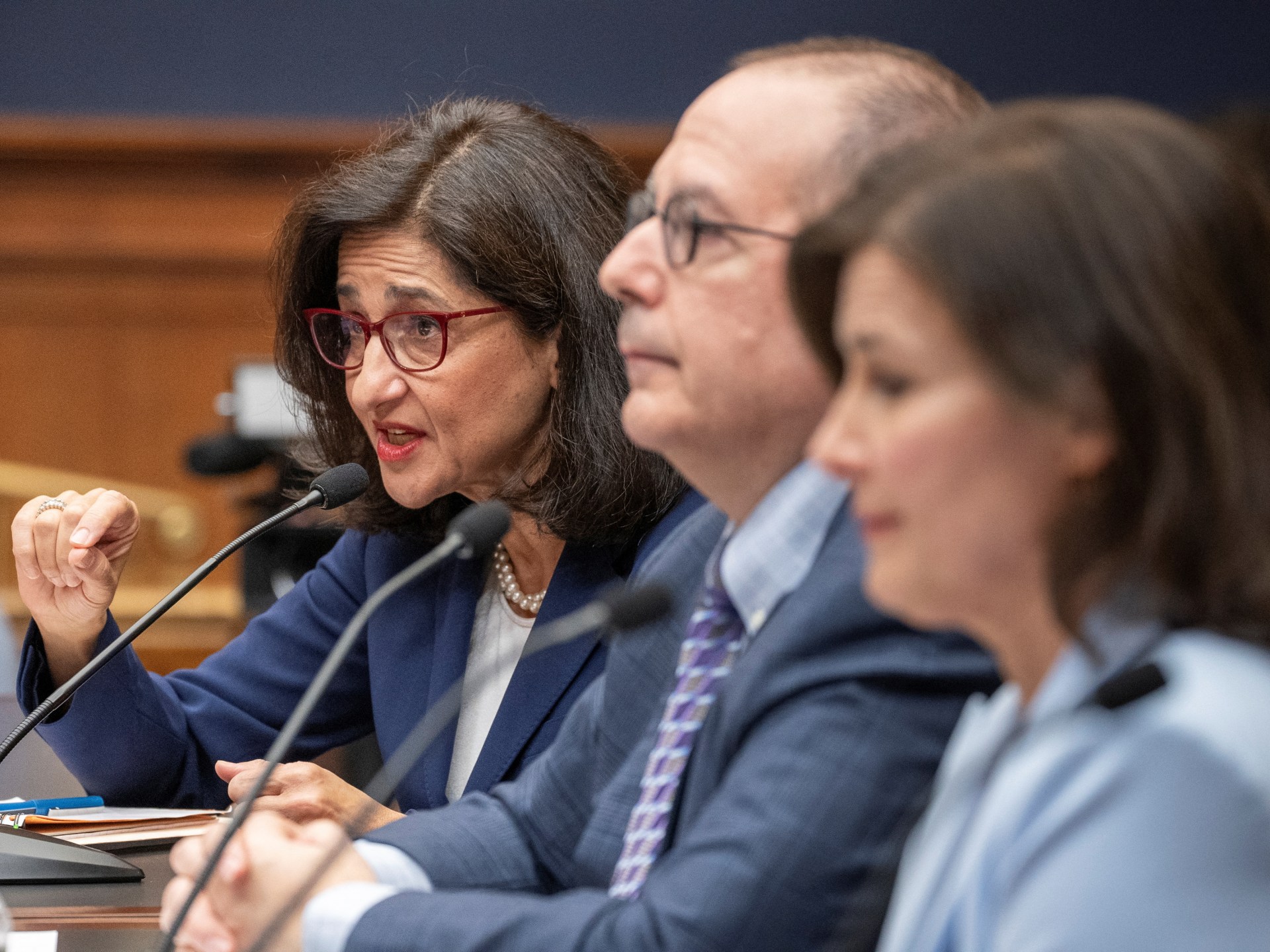
 World1 week ago
World1 week agoColumbia University leaders face scrutiny over anti-Semitism on campus
-

 News1 week ago
News1 week agoHouse passes bill requiring warrant to purchase data from third parties
-

 Politics1 week ago
Politics1 week agoTrump trial: Jury selection to resume in New York City for 3rd day in former president's trial
-

 Politics1 week ago
Politics1 week agoFormer Wisconsin Democratic Rep. Peter Barca launches congressional comeback bid
-
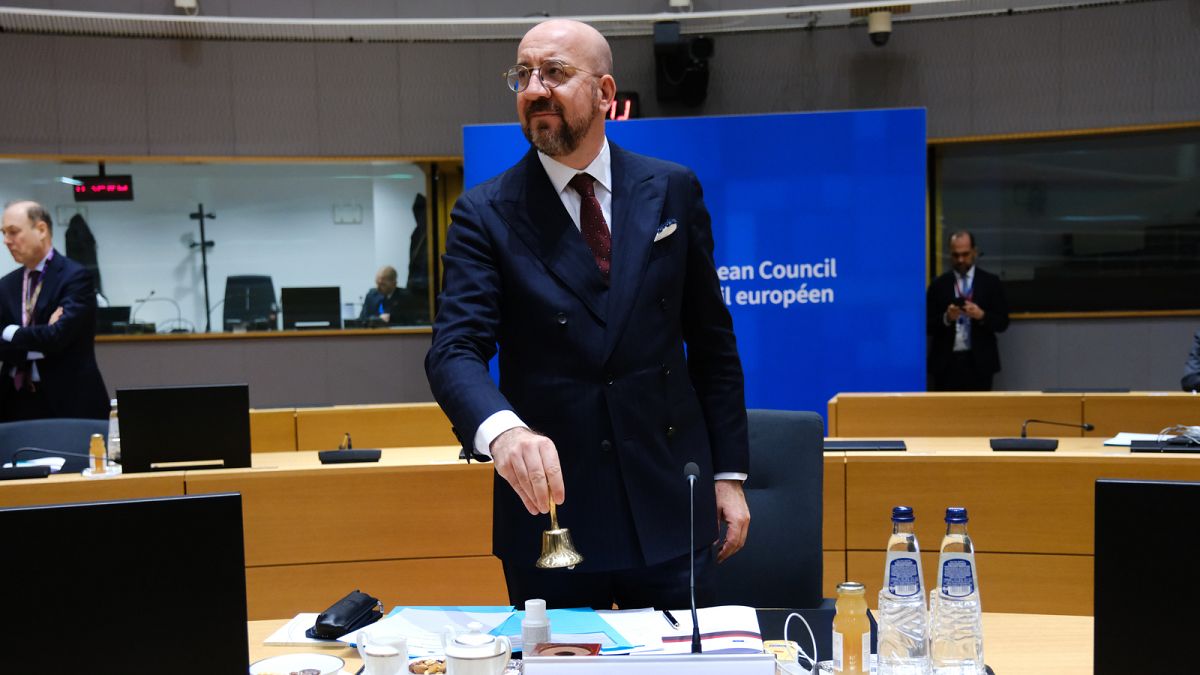
 World1 week ago
World1 week agoEU leaders weigh Lebanon partnership in response to Middle East crisis

